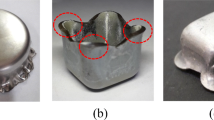Abstract
This paper presents experimental and simulation study to minimize residual stress in cylindrical deep-drawing process. Eight significant process parameters including initial blank thickness, punch and die shoulder radii, blank–holder force, punch velocity, and coefficients of friction between die–blank, holder–blank, and punch–blank are considered. According to number of parameters, the Taguchi’s method is employed to perform design of experiments. The die is designed and manufactured, and the experiments are carried out using AISI 1006 carbon steel sheet. Hole-drilling method based on ASTM E 837-99 standard is applied to measure the residual stresses in drawn cups. Moreover, the deep-drawing process is simulated wholly using ABAQUS/explicit software and the accuracy of finite-element model is verified using experimental results. Finally, the analysis of variance method is applied to define the most important parameters and obtain an optimum level to minimize the residual stress in cylindrical deep-drawing process.













Similar content being viewed by others
Abbreviations
- BHF:
-
Blank–holder force (KN)
- r d :
-
Die shoulder radius (mm)
- r p :
-
Punch shoulder radius (mm)
- µ d :
-
Coefficient of friction between die and blank
- µ h :
-
Coefficient of friction between holder and blank
- µ p :
-
Coefficient of friction between punch and blank
References
Reddy BL, Ravindra Reddy PVR, Chenna Kesava Rao B (2013) A review on residual stresses in deep drawing. Int J Inno Res Sci Eng Technol 3(2):802–804
Kuriyama S, Yoshida Y, Takahashi T, Kumagaya S, Aoki T, Miyauchi K (2003) Development of simulation code for calculating residual stress distribution in D-I cans produced by both-sided ironing process. J Mater Process Technol 140:13–18
Incandela O, Tabourot L, Porret P, Balland P, Arrieux R, Ducher F (2004) Modelling and analysis of a deep-drawing operation: key factors for successful comparisons between experimental and simulated results. J Mater Process Technol 155–156:1105–1110
Padmanabhan R, Oliveira MC, Alves JL, Menezes LF (2008) Numerical simulation and analysis on the deep drawing of LPG bottles. J Mater Process Technol 200:416–423
Pourkamali Anaraki A, Shahabizadeh M, Babaee B (2012) Finite element simulation of multi-stage deep drawing processes & comparison with experimental results. World Acad Sci Eng Technol 6:1–21
Danckert J (1994) The residual stress distribution in the wall of a deep-drawn and ironed cup determined experimentally and by FEM. CIRP Ann Manuf Technol 43(1):249–252
Ragab MS, Orban HZ (2000) Effect of ironing on the residual stresses in deep drawn cups. J Mater Process Technol 99:54–61
Singh SK, Kumar V, Reddy PP, Gupta AK (2014) Finite element simulation of ironing process under warm conditions. J Mater Process Technol 3(1):71–78
Padmanabhan R, Oliveira MC, Laurent H, Alves JL, Menezes LF (2009) Study on springback in deep drawn tailor welded blanks. Int J Mater Form 1:829–832
Hassan H, Maqbool F, Güner A, Hartmaier A, Ben Khalifa N, Tekkaya AE (2016) Springback prediction and reduction in deep drawing under influence of unloading modulus degradation. Int J Mater Form 9:619–633
Danckert J (1995) Reduction of the residual stresses in a deep-drawn cup by modifying the draw die profile. CIRP Ann Manuf Technol 44(1):259–262
Gnaeupel-Herold T, Foecke TJ, Prask H, Fields R (2005) An investigation of springback stresses in AISI-1010 deep drawn cups. Mater Sci Eng A 399:26–32
Brabie GH, Nanu NE, Radu M (2009) The influence of the punch shape on the residual stresses distribution and spring back in the case of conical drawn parts. The Ann of “Dunărea De Jos” University Of Galaţi Fascicle V Technol In Mach Build; ISSN 1221-4566
Sherbiny ME, Zein H, Abd-Rabou M, Shazly ME (2014) Thinning and residual stresses of sheet metal in the deep drawing process. Mater Des 55:869–879
Colgan M, Monaghan J (2003) Deep drawing process: analysis and experiment. J Mater Process Technol 132:35–41
Browne MT, Hillery MT (2003) Optimizing the variables when deep-drawing C.R.1 cups. J Mater Process Technol 136:64–71
Raju S, Ganesan G, Karthikeyan R (2010) Influence of variables in deep drawing of AA 6061 sheet. Trans Nonferr Met Soc China 20:1856–1862
Venkateswarlu G, Davidson MJ, Tagore GRN (2010) Influence of process parameters on the cup drawing of aluminum 7075 sheet. Int J Eng Sci Technol 2(11):41–49
Roy RK (2010) A primer on the Taguchi method. 2nd edn, SME
Rossini N, Dassisti M, Benyounis K, Olabi A (2012) Methods of measuring residual stresses in components. Mater Des 35:572–588
ASTM E837-13a (2000) Test method for determining residual stresses by the hole-drilling strain-gage method
ASTM E8M-16a (2004) Standard test methods for tension testing of metallic materials [metric]
Tigrinho LMV, Santos RA, Chemin Filho RA, Marcondes PV (2008) Experimental investigation on the influence of the lubricant type in the punch stretching of extra deep-drawing steel. J Braz Soc Mech Sci Eng 30:290–294
Acknowledgements
The authors are grateful for the research support of the Iran National Science Foundation (INSF).
Author information
Authors and Affiliations
Corresponding author
Additional information
Technical Editor: Márcio Bacci da Silva.
Rights and permissions
About this article
Cite this article
Kardan, M., Parvizi, A. & Askari, A. Influence of process parameters on residual stresses in deep-drawing process with FEM and experimental evaluations. J Braz. Soc. Mech. Sci. Eng. 40, 157 (2018). https://doi.org/10.1007/s40430-018-1085-9
Received:
Accepted:
Published:
DOI: https://doi.org/10.1007/s40430-018-1085-9



